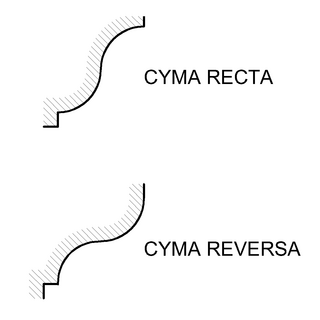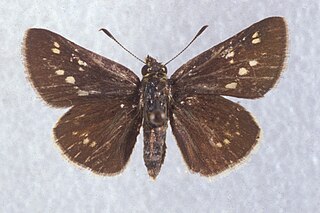
An ogee ( ) is an object, element, or curve—often seen in architecture and building trades—that has a serpentine- or extended S-shape (sigmoid). Ogees consist of a "double curve", the combination of two semicircular curves or arcs that, as a result of a point of inflection from concave to convex or vice versa, have ends of the overall curve that point in opposite directions.

Cymatium, the uppermost molding at the top of the cornice in the classical order, is made of the s-shaped cyma molding, combining a concave cavetto with a convex ovolo. It is characteristic of Ionic columns and can appear as part of the entablature, the epistyle or architrave, which is the lintel or beam that rests on the capitals of columns, and the capital itself. Often the cymatium is decorated with a palmette or egg-and-dart ornament on the surface of the molding.
The heights of the parts of the capital are to be so regulated that three of the nine parts and a half, into which it was divided, lie below the level of the astragal on the top of the shaft. The remaining parts are for the cymatium, abacus, and channel. The projection of the cymatium beyond the abacus is not to be greater than the size of the diameter of the eye [of the volute].

Histioteuthis reversa, commonly known as the reverse jewel squid or the elongate jewel squid, is a species of cock-eyed squid, so called because the eyes are dissimilar. It occurs at moderate depths in the Atlantic Ocean and the Mediterranean Sea. It is also known from the Indian Ocean.
Paracles is a genus of moths in the subfamily Arctiinae. The genus was described by Francis Walker in 1855. The species range from Panama to Patagonia, with quite a few in the southern temperate region of South America.

Amblyscirtes is a genus of skipper butterflies in the family Hesperiidae. The genus was erected by Samuel Hubbard Scudder in 1872.

Amblyscirtes reversa, the reversed roadside skipper, is a butterfly of the family Hesperiidae. The species was first described by Frank Morton Jones in 1926. It has a scattered distribution from south-eastern Virginia, south to northern Georgia. It is also found in southern Mississippi and southern Illinois.
Prosipho is a genus of sea snails, marine gastropod mollusks in the family Buccinidae, the true whelks.

Haploa reversa, the reversed haploa, is a moth of the family Erebidae. The species was first described by Stretch in 1885. It is found in North America, from south-eastern Illinois, Iowa, Kansas, New York, Oklahoma and Wisconsin.
Paracles amarga is a moth of the subfamily Arctiinae first described by Schaus in 1933. It is found in Argentina.
Paracles vivida is a moth of the subfamily Arctiinae first described by Rothschild in 1910. It is found in Venezuela.
Paracles uniformis is a moth of the subfamily Arctiinae first described by E. Dukinfield Jones in 1912. It is found in Brazil.
Paracles bilinea is a moth of the subfamily Arctiinae first described by Schaus in 1901. It is found in Brazil.
Paracles discalis is a moth of the subfamily Arctiinae first described by George Hampson in 1905. It is found in Paraguay.
Paracles gigantea is a moth of the subfamily Arctiinae first described by E. Dukinfield Jones in 1908. It is found in Brazil.
Paracles nitida is a moth of the subfamily Arctiinae first described by E. Dukinfield Jones in 1908. It is found in Brazil.
Paracles insipida is a moth of the subfamily Arctiinae first described by Rothschild in 1910. It is found in Argentina.
Paracles pectinalis is a moth of the subfamily Arctiinae first described by E. Dukinfield Jones in 1908. It is found in Brazil.
Paracles sericea is a moth of the subfamily Arctiinae first described by William Schaus in 1896. It is found in Brazil.
Paracles valstana is a moth of the subfamily Arctiinae first described by Schaus in 1933. It is found in Argentina.
Paracles cnethocampoides is a moth of the subfamily Arctiinae first described by Rothschild in 1910. It is found in Argentina.





